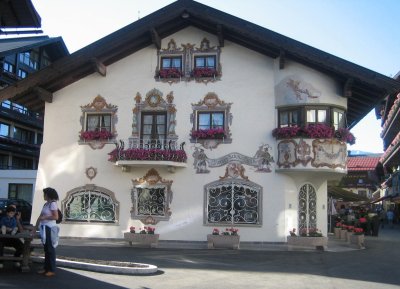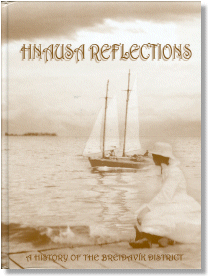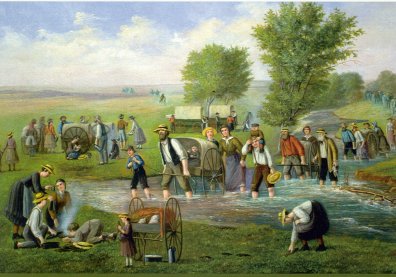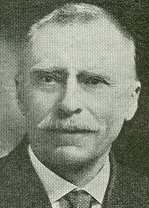The Emigration from Iceland to North America Once a Weekly Newsletter - Nr 49
|
 |
| August 1 2005 | Keeping in touch as often as possible!
|
|
| Small talk |
June 16th I wrote you a small letter, telling that I was about to take a two weeks vacation to Tyrol in Austria and Lake Garda in Northern Italy. Well, when back I intended to write a small Newsletter, but as always - I live by the motto: "What you can do today, you can as well do it tomorrow!" Anyway, the trip was great. I like travelling (If I could afford it I would do much more of that), seeing new places, meeting new people and so on.
 |
| Houses in Seefeld are beautifully decorated |
We had a great guide. A young Icelandic woman which we had met before as she guided us when we (my wife and I) visited Wienna last year. She lives in Wienna and had now come down to Bologna, Italy, to meet the group of 34 Icelanders and bring us to the small town of Seefeld in Tyrol, where we stayed for the first week. When meeting people, genealogy is never far away :-) This young woman is Gunnhildur Gunnars- dóttir, first cousin to Steinţór Guđbjartsson, the awarded editor of Logberg Heimskringla, the "Ice- landic" newspaper published in Winnipeg. Awarded? See below.
Yes, Gunnhildur brought us to Seefeld, a beautiful village, situated on a high plateau in the Austrian alps, surrounded with high woody mountains with snow caps. From Seefeld there are short distances to interesting and beautiful places, like Innsbruck with the famous Swarowsky crystal world just outside the city. Just north of the German border is the Nationa park Berchtesgaden where The Eagle's Nest (Elevation 1834 m (6017 ft)) overlooks the wonderful surroundings.
From Seefeld, Gunnhildur took us to the willage Bardolino on the eastern coast of Lake Garda. The lake is like a jewel in the landscape and numerous villages are like pearls on a string that surrounds the lake. A boat trip on the lake is a must as well as a wisit to the small village Sirimione with it's - maybe 2000 years - old ruins. A tour to the cities of Verona and Venice was on the program. I really like it hot, but in Verona it was to much for me - 41°C or 106°F. And Venice? Too many tourists!
Some few pictures.
|
| Hnausa Reflections |

|
|
The Hnausa book |
Early November last year, I ordered the book Hnausa Reflections from Canada, from Manitoba. It was posted November 12th and I was really ancious to get it in my hands but had to wait for it for almost three months. Didn't realize that it had been sent by surface mail so I received the book in the beginning of February, this year. It took about the same time for me to get the book as it took the emigrants to travel from Iceland to the settlements in Canada or US in the 19th century. By foot, by ship, by train, by wagon, by foot. Anyway, the book was worht waiting for. It tells interesting stories about the community of Hnausa and the people - mainly Icelandic people - that lived there and their descendants that still live there and occupy a part of the Lake Winnipeg shore called Hnausa.
Hnausa? How come? I quote the well known historian Nelson Gerrard who wrote "How Hnausa got its name" in the book.
"The community we now know as Hnausa was originally called Breiđavík, meaning Broad Bay. This name, descriptive of the district's location spanning the beautiful crescent of lakeshore extending north from Árnes (Drunken Point) to Sandy Bar, was chosen by the first Icelandic scouts who explored the west shore of Lake Winnipeg in the summer of 1875, and it was used exclusively during the first years of the settlement, though technically this township (22-4E) was part of a larger administrative district called Fljótsbyggđ (River District)."...........
"The name Hnausa first officially appeared in associatíon with the Breiđavík district in 1890 when a post office was established in the home of Rev. Magnús J.Skaptason, whose family home and birthplace in Iceland was the farm Hnausar in Northern Iceland. The official address was Hnausa Post Office or Hnausa P.O. - for which reason the genitive form, Hnausa, gradually became associated with the entire community and eventually appeared on maps, road signs, and businesses.
In spoken Icelandic, however, the district was commonly referred to as Breiđavík by area residents and Lake Winnipeg fishermen until well into the latter decades of the 20th Century."
I highly recommend this book to all those interested in the history of Icelanders in North America.
|
| Magnús J. Skaptason |
Rev. Magnus J. Skaftason (mentioned above) came to Canada in 1887. He had been a serving minister in Iceland since 1875 and in Canada he became a minister in the Lutheran convergation in New Iceland. Later he became Unitarian and served the Unitarian convergation in Winnipeg and Gimli.
Magnús was born 4 Feb. 1850 at the farm Hnausar in Húnavatnssýsla county, son of MD Jósef Skaftason (1802-1875) and Anna Margrét Björnsdóttir Ólsen (1814-1885). In 1876 Magnus married Valgerđur Sigurgeirsdóttir, b. 8 Apr 1855 and in 1887 they emigrated with their three children, Marta Ólöf, Anna Valgerđur and Jósef. At Hnausa in Manitoba they had one more child, Fanney Guđrún. Marta Ólöf married Magnús Björnsson in Winnipeg, they had three children: Olive Margaretta, Magnús Edward Marion and Helen Priscilla Valgerđur. Anna Valgerđur married William Henry Adams in Botteneau in N-Dakota, they had one daughter Merry Margaret, Jósef was a parmacist in Winnipeg and later in Chicago, unmarried, Fanney Guđrún married William Cook in St. James in Manitoba, they had four children: Eleanor, Muriel, Ralph and Frederick. Any of you related to this family and able to add some descendants to my database? That would be really great!
|
| What's on? |
I want to tell you that early this year, May 7th, a very interesting exhibition called The Road to Zion, was opened in The Culture House in Reykjavík. The exhibition was opened by the Minister of foreign affairs, Mr. Davíđ Oddsson. The visitors at the opening ceremony were also addressed by my good friend, Mr. David A. Asby, former president of The Icelandic Association of Utah. The exhibit, which is still open, is to commemorate that a century and a half have passed since the first Icelanders started their ocean voyage west to settle down in a new home, the "promised land".
 |
| This painting depicts a group of Scandinavian Latter-day Saints on the trail. |
The emigration from Iceland is usually associated with the period of 1870-1914, when thousands of Icelanders set off to try their luck in a new place. Most went to Canada. The story related in the exhibit begins earlier, in about 1855. The destination was not Canada or the northern United States, but a certain area that had been designated as Zion or the "promised land", Utah.
Ţórđur Diđriksson (1828-1894) was one of the first Icelanders to emigrate to Utah. He set off in 1855 for the promised land. He went to Copenhagen and the following year he found a berth to New York. Finally he travelled overland to Utah. Didriksson's journey was long and hard, and he wrote about it soon after his arrival. The account was published in Ólafur S. Thorgríms- son's Almanak of 1920.
"The first few days on the Atlantíc we had good weather, but when we were a few hundred miles out to sea, we had a headwind for 14 days, driving us back somewhat every day. With the weather so bad, nearly all the passengers became seasick. I was very sick myself and so afraid I would die that I could not sleep.... Once there was a terrible storm lasting three days. Everything that was loose on the ship was tied down so it would not tip over or rock from side to side, and people could scarcely hold themselves in bed. ... It took exactly ten weeks (70days) to make the voyage from England to New York, and by that time we had nearly run out of coad and water. ...
"We were in Omaha for three weeks, to prepare for the handcart journey across the prairie. There were 220 emigrants in the company. We had twelve tents and 48 handcarts, each of which had four or five persons to pull and push the heavy load. From 16 to 20 people were intended to occupy each tent while camping. ... After three months we reached Salt Lake City. ... We were advised to sell any luggage except the bare necessities, in order not to have so much to lug along. ... The men pulled the carts and women pushed. It was extremely strenuous, moving those heavy carts over hills and valleys, through grass, sand and rivers. ... There were 30 children in the company, and early every morning they were all sent ahead of the adults in one bunch. Some of them had very little clothing, though they all wort hats. They were driven along with willow switches and had to keep walking as long as they were able. It was no use crying or complaining, but during the heat of day they were allowed to rest and were given food. They were often two or three miles ahead of us. It was hard for the parents to see their five- or six-year-olds driven like sheep."
That was a small part of Ţórđur Diđriksson's story. If you are heading for Iceland in near future, turn your footsteps to the Culture House. It's very central in Reykjavík. This exhibition is still on.
|
| Lögberg-Heimskringla |
 I think I have mentioned Lögberg Heimskringla before in my letters - once or twice at least. The Icelandic paper published in Winnipeg. Yes, briefly in my number 23.
And yes, the paper is in English, so you won't have any difficulties reading it. The hard working Editor, since March last year - and first cousin to my favourite guide - Steinţór Guđbjartsson, was last June selected to receive The Canadian Ethnic Journalists' and Writers' Club highest award for ethnic writing in Canada. His articles on the "Icelandic communities" in North America are really incredible. It's a bit late Steinţór, but - Congratulations!
It would be interesting to know how many of my list members subscribe to Logberg Heimskringla. Let me know if you do by sending me an email. I hope my "mailbox" will be flooded - for the first time :-) And if you don't subscribe, it's about time to do. Also - online subscription gives you possibility to read previous issues back to January 2002. So - don't hesitate!

Subscribe to the Icelandic Paper Lögberg-Heimskringla and read it online.
| My online database |
Just click in the GenWeb-logo below and check on your Icelandic ancestors. As I have told before, the database is partly locked, so if you see a lot of X's it means that you need a password to search further. Right now the database holds 517.867 names and it's constantly growing. I'm sure you can help me!
|
| Pictures from Iceland |

Click onsimnet.is
www.myndasafn.is and browse through what is just a tiny bit of Mats Wibe Lund's huge picture gallery of places all over in Iceland. If you really want a fine picture of where your ancestors lived, just contact him.
|
| |
|
| |







